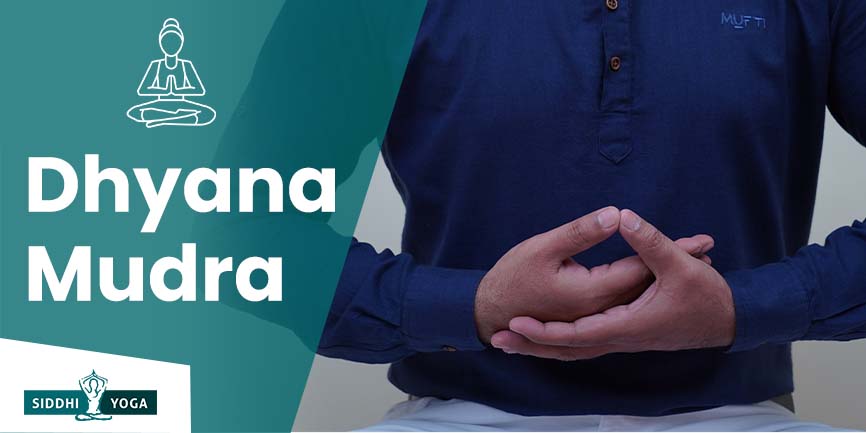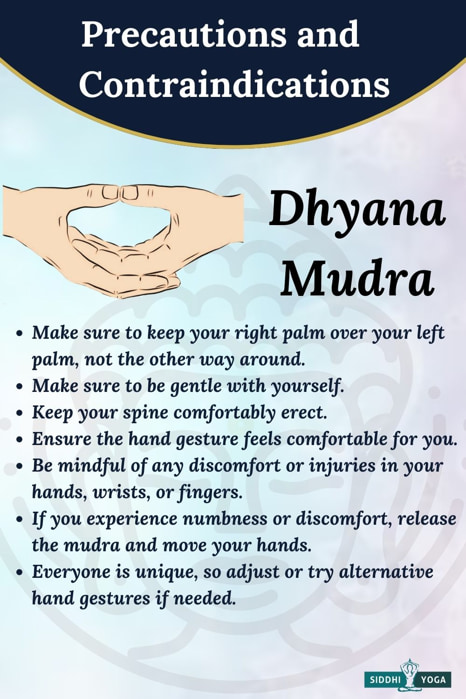
The Dhyana Mudra is a hand gesture that has many benefits. Here’s how to do it, its meaning, and the associated benefits of this Mudra.
Definition – What is Dhyana Mudra and its Meaning, References, and Mythology?
Dhyana Mudra is an “Hasta Mudra” type of hand gesture/seal.
The word Dhyana translates into Meditation.
So, the literal meaning of this Mudra is a Meditative gesture/seal.
Maharshi Patanjali has defined Dhyana in his “Yoga Sutra” as:
Tatra pratyaya-ikatānatā dhyānam
~ Yoga Sutra of Patanjali [Chapter 3. Verse 2]
According to Maharshi Patanjali, Dhyana is a state of mind where we concentrate on a single object for an extended time and where thoughts flow without interruption.
This is one of the Mudras practiced by Hindu and Buddhist Monks for centuries. Dhyana Mudra practices can be seen in different traditions such as Hindu traditions & Buddha traditions. It is very effective if you are looking to concentrate on some object or if you want to practice Dhyana. You can find many sculptures where different sages can be seen practicing Dhyana in Dhyana Mudra.
The word Dhyana is made of two different metals (called Dhatu in Sanskrit.)
Dhi+Yana= Dhyana
“Dhi” is the ability to think, and “Yana” means “a vehicle.”
So, whatever drives your thinking is Dhyana.
When you practice Dhyana Mudra and set up an intention, you signal to this universe that you are ready to receive positive energy. The bowl you create with your hands is filled with positive thoughts, vibes, and energy.
According to Buddha tradition, it is believed that the triangle formed by practicing this represents three jewels of Buddhism: Buddha, Sangha (community), and dharma (One’s duty/good law). It is believed that it is one of the Mudras that Buddha practiced to attain enlightenment. However, one thing to note is that the Yogis practiced this Mudra before Buddha.
In classical Dhyana (Meditation), you think nothing at all. You do not indulge yourself in anything. You sit and meditate.
It helps to establish a better connection between the five elements as well.
Alternate Names of Dhyana Mudra
Yoga mudra or Samadhi mudra.
How to Do Dhyana Mudra?
- This Mudra is specific to practicing Meditation or Dhyana. So, to gain maximum benefits of this Mudra, start by sitting in a comfortable meditative posture (Sukhasana, Padmasana, or Swastikasana). Whichever meditative posture is comfortable for you to practice for a long time.
- Keep your neck and spine comfortably erect.
- Rest both of your palms comfortably on your knee. Palms facing upward towards the sky.
- Gently close your eyes.
- Now, slowly bring your left hand over your pubis, keeping the palm facing upward towards the sky. And then, slowly, and gently, keeping the right palm facing upward, bring it over the left palm in such a manner that it would seem like a vessel or pot. This symbolizes that you are ready to receive whatever nature has to offer.
- Now, while maintaining this, comfortably join the tips of your thumbs. Make sure to keep the direction of your thumbs pointed upward towards the sky such that a triangular formation should be formed.
- Now, start to meditate. Distant yourself from your thoughts.
- Witness your breath without losing awareness of your breath. But once you get better with your practice, you lose the awareness of your breath.
- You can practice it with different types of Meditation techniques.
You may also like: Online Yoga Teacher Training
Dhyana Mudra Benefits

- To deepen your Meditative practice: to understand the effects of this Mudra all by yourself, I recommend you sit in any comfortable meditative posture and, without any intention, sit and observe the flow of your breath. You don’t even need to deepen your breath. Just observe your breath while practicing Dhyana Mudra. And you will witness how it works.
- It helps to concentrate and makes you feel more focused.
- If you have too many thoughts in your mind that you cannot relax, then practicing this will result in a clearer thought process.
- It reduces negative emotions such as stress, anxiety, anger, etc.
- It improves the quality of your sleep. You feel fresher throughout the day.
- As it calms the mind, it improves our body’s healing response.
Dhyana Mudra Precautions and Contraindications

Similar to all other Mudra practices, it has no side effects.
However, there are a few things to consider:
- Make sure to keep your right palm over your left palm, not the other way around.
- Make sure to be gentle with yourself.
- Keep your spine comfortably erect.
When and how long to do Dhyana Mudra?
- If you want to get better with your meditation practices, try practicing this in conjunction with Pranayama. You will become more meditative and can maximize the outcomes of your practice.
- You can practice this if you find yourself surrounded by stressors. It will help you to distance yourself from all the negativities.
- If you are experiencing any sleep-related issues, you should try it.
- If you have stress issues, memory loss, and digestive issues, then it serves a great value.
Morning is the ideal time to do any yoga or Mudra. Our brain is at its best in the morning and during the daytime. So, you are more likely to be able to concentrate easily. Therefore, you should practice this Mudra from 4 am and 6 am to get the most effective outcomes.
If you are having difficulty with this during the morning, you can do this Mudra later in the evening too.
Practicing this Mudra for a minimum of 30-40 minutes daily is recommended. Whether you wish to complete it in one stretch or two threes that last between 10 and 15 minutes, it’s up to you. Based on research, the best way to practice an exercise for at least 20 minutes is to get the best benefits of that particular Mudra.
Breathing in Dhyana Mudra
Visualization in Dhyana Mudra
- Imagine an object, perhaps a circular or triangular object.
- Imagine whatever you can which brings you close to the divinity.
Affirmation in Dhyana Mudra
“I am aware. I am witnessing every positive thing.”
Conclusion
The Dhyana Mudra is a well-known Mudra, or hand gesture, often associated with yoga and Meditation. This Mudra has many benefits, including promoting concentration, relieving stress and anxiety, and helping to ease headaches. If you’re interested in learning more about this Mudra and other Mudras, check out our Mudras Certification Course. This course includes all 108 Mudras, complete with photos and step-by-step instructions, so you can start incorporating them into your practice today.
Responses